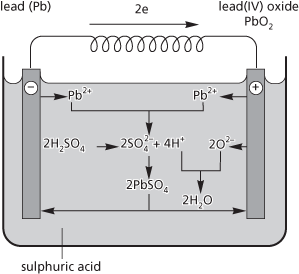An accumulator in which the electrodes are made of lead and the electrolyte consists of dilute sulphuric acid. The electrodes are usually cast from a lead alloy containing 7–12% of antimony (to give increased hardness and corrosion resistance) and a small amount of tin (for better casting properties). The electrodes are coated with a paste of lead(II) oxide (PbO) and finely divided lead; after insertion into the electrolyte a ‘forming’ current is passed through the cell to convert the PbO on the negative plate into a sponge of finely divided lead. On the positive plate the PbO is converted to lead(IV) oxide (PbO2). The equation for the overall reaction during discharge is:
The reaction is reversed during charging. Each cell gives an e.m.f. of about 2 volts and in motor vehicles a 12-volt battery of six cells is usually used. The lead–acid battery produces 80–120 kJ per kilogram. Compare nickel–iron accumulator.

Lead–acid accumulator.
- charisma
- charity, principle of
- Charlemagne
- Charles I (1600–49)
- Charles II (1630–85)
- Charles II (1661–1700)
- Charles II (823–77)
- Charles III (1716–88)
- Charles III (839–88)
- Charles I of Anjou (1226–85)
- Charles IV (1316–78)
- Charles, Jacques Alexandre César
- Charles, Jacques Alexandre César (1746–1823)
- Charles, King (1948)
- Charles Martel (688–741)
- Charles the Bold (1433–77)
- Charles V (1337–80)
- Charles V (1500–58)
- Charles VII (1403–61)
- Charles X (1757–1836)
- Charles XII (1682–1718)
- Charles XIV (1763–1844)
- Charles’ law
- Charles’s law
- Charlie, Bonnie Prince